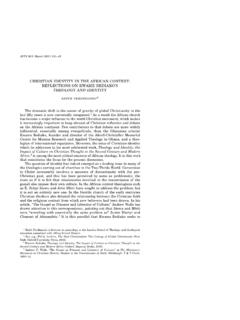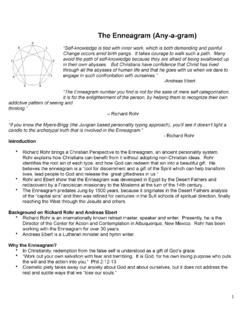Transcription of A Welcoming Toolkit 2 - welcomingresources.org
1 Building anInclusive ChurchA Welcoming Toolkit Your Congregation Become a Communitythat Openly Welcomes People of All SexualOrientations and Gender IdentitiesBuilding an Inclusive ChurchA Welcoming Toolkit Your Congregation Become a Community that Openly Welcomes People of All Sexual Orientations and Gender Identities 2009, 2013 National Gay and Lesbian Task Force s Institute for Welcoming Resources1325 Massachusetts Avenue NW, Suite 600 Washington, DC an Inclusive Church: A Welcoming ToolkitWritten and compiled in 2009 by Rev. Rebecca Voelkel, Rev. Vicki Wunsch, and David Lohman. Revised and expanded in 2013 by Rev. Rebecca Voelkel, David Lohman, and Tim the 2009 Edition:This Toolkit would not have been possible without the years of work, experience and support of the leaders of the Welcoming Church Programs with whom we partner:Dr.
2 Michael Adee More Light Presbyterians in the Presbyterian Church (USA)Kerry Armstrong Open and Affirming Program of Gay/Lesbian Affirming Disciples in the Christian Church (Disciples of Christ)Meredith Bischoff Welcoming Community Network in the Community of ChristJohn Clinton Bradley Integrity USA in the Episcopal Church USARev. Ruth Garwood Open and Affirming Program of the United Church of Christ Coalition for LGBT ConcernsRev. Dr. Sally Harris Affirm United/S affirmer Ensemble in the United Church of CanadaRev. Ken Pennings Association of Welcoming and Affirming Baptists in the American Baptist Churches and the Alliance of BaptistsRev. Troy Plummer Reconciling Ministries Network in the United Methodist Church Rev. Robert Williams Room for All in the Reformed Church in AmericaRev. Carol Wise Supportive Community Network of the Brethren Mennonite Council for LGBT InterestsIn particular, Emily Eastwood, Executive Director of the Reconciling in Christ Program of Lutherans Concerned/North American deserves the lion share of credit for bringing the vision of relational organizing to the Welcoming the 2013 Edition: The authors wish to particularly thank Rachel Harvey and Rev.
3 Troy Plummer of the Reconciling Ministries Network and Emily Eastwood of ReconcilingWorks: Lutherans for Full Participation for encouraging this revision and update process. The changes and updates are rooted in the experience of all of us who have used Building an Inclusive Church: A Welcoming Toolkit as a training tool with hundreds of people. We hope the changes we have made will make it even more useful and relevant to your work and Bischoff Welcoming Community Network in the Community of ChristDavid Cupps Integrity USA in the Episcopal Church USAE mily Eastwood ReconcilingWorks: Lutherans for Full Participation in the Evangelical Lutheran Church in AmericaDr. Patrick Evans More Light Presbyterians in the Presbyterian Church (USA)Rev. Dr. Sally Harris Affirm United/S affirmer Ensemble in the United Church of CanadaDr.
4 Mark Johnston The GLAD Alliance in the Christian Church (Disciples of Christ)Andy Lang Open and Affirming Program of the United Church of Christ Coalition for LGBT ConcernsJustin Lee Gay Christian NetworkRev. Robin Lunn Association of Welcoming and Affirming Baptists in the American Baptist Churches and the Alliance of BaptistsMarilyn Paarlberg Room for All in the Reformed Church in AmericaRev. Troy Plummer Reconciling Ministries Network in the United Methodist Church Rev. Carol Wise Brethren Mennonite Council for LGBT Interests in the Church of the Brethren, Mennonite Church USA and Mennonite Church CanadaTable of ContentsINTRODUCTIONPART A 3 The Welcoming Process: Laying the Groundwork 3 Tool: Graceful Engagement 4 Step One: Leading the Process 4 Tool: One-to-One Visits 4 Step Two: Gathering Information 6 Tool: Choosing the Right Frame 6 Step Three: Outlining Your ProcessPART B 7 The Welcoming Process: Taking it Public 7 Step Four: Building Relationships 7 Tool: Public Storytelling 7 Step Five: Making it Official 8 Step Six: Setting the Frame and Providing Educational Opportunities 9 Step Seven: Writing Your Welcoming Statement 10 Step Eight: Conducting an Exploratory Survey 10 Step Nine: Holding the Vote 10 Step Ten: Celebrating and Publicizing 11 Step Eleven.
5 We re Now What?APPENDICES 12 Appendix One: Graceful Engagement Worksheet 14 Appendix Two: Sustainable Action: Planting the Seeds of Relational Organizing 18 Appendix Three: Congregational Assessment and Welcoming Process Outline 26 Appendix Four: Congregations and Conflict 30 Appendix Five: How Does Change Happen in Churches or Any Organization 32 Appendix Six: Framing Worksheet 37 Appendix Seven: Telling Your Public Story: Self, Us, Now 40 Appendix Eight: Public Storytelling and the Welcoming Church Movement Worksheet 43 Appendix Nine: Sexual Orientation and Gender Identity 49 Appendix Ten: Sample Welcoming Statements 51 Appendix Eleven: We re Now What? A Check List 54 Appendix Twelve: Resources, Resources, Resources 60 Welcoming Church ProgramsNational Gay and Lesbian Task Force s Institute for Welcoming Resources Welcoming Toolkit1 Welcome, we are so glad you are here!
6 These words of welcome and the accompanying atmosphere of support, understanding and love are what we all long for as we enter our churches, live as members, or experience important life-cycle events (falling in love, marrying, having children, baptism, confirmation, coming out, transitioning, etc.). This experience of God s Extravagant Welcome and the justice and societal witness that go with it are the heart of what we hope to facilitate with Building an Inclusive Church: A Welcoming Toolkit Em-bodying God s Extravagant Welcome is both a critical goal of this Toolkit , for it calls upon the very core of the Christian gospel, and it is a goal that requires prayerful, conscious, faithful action. A Welcoming Process is an officially recognized path that includes relational organizing, education, some kind of public vote and a public statement of Welcome for persons of ALL sexual orientations and gen-der identities.
7 Additionally, we have sought to use general language in this Toolkit . For instance, we use Welcoming , but within the Lutheran and Methodist traditions, it is known as Reconciling and, within the United Church of Christ and the Christian Church (Disciples of Christ), Open and Affirming. Thank you for joining with us. And may God bless and guide us in the Toolkit is designed as a guide for a small group of congregants who wish to facilitate a Welcoming Process in their local congregation. As we compile it, we make four important assumptions:1. A Welcoming Process needs to be well-thought out, planned and drawing upon wisdom from other congregations that have done a process of their A Welcoming Process needs to be grounded in the culture and personality of the A Welcoming Process needs to be based in relationship-building with the pastor, the formal lay leadership (councils, boards, sessions, etc.)
8 And the informal lay leadership ( pillars of the church, matriarchs, patriarchs, etc.) and the rest of the congregation. This is known as relational organizing, and one of its key components is listening deeply to what God is saying and doing in the individual and in the congregation. Relational organizing is very different from debate, which should be avoided. 4. A Welcoming Process is a spiritual opportunity for the congregation to grow in membership, stewardship and As such, it should always be presented in the context of the life of faith of the a Welcoming Process is rooted in relational organizing. Relational organizing strives to take seriously our role as the Body of Christ, and building and strengthening relationships within the congregation is central to the work. These relationships include those amongst leadership, within key areas of ministry, across ideological and affinity-group lines and across genera-tional and cultural Welcoming Process has key parts that are somewhat linear.
9 We strongly encourage you to follow the wisdom presented in this Toolkit . However, in the end, crafting a Welcoming Process is more of an art than a science. Therefore, the assessment of your congregation its culture and personality, its theological roots, its likely pace with Welcoming issues is For the positive impact Welcoming processes can have on stewardship and membership numbers, see Heckles, Rev. Dr. Jane, Stewardship Trends in Open & Affirming Churches of the United Church of Christ, [Doctor of Ministry Thesis, Andover-Newton Theological Seminary: Newton Centre, MA, 1997]. For the posi-tive impact Welcoming processes can have on vitality see Voelkel, Rev. Dr. Rebecca, To Do Justice: A Study of Welcoming Congregations, [National Gay and Lesbian Task Force, 2009]. For these and many other resources to support a Welcoming Process, visit Gay and Lesbian Task Force s Institute for Welcoming Resources Welcoming Toolkit2 Part A of this Toolkit is designed to help you lay all the groundwork you need before you begin a public educational process.
10 We cannot overemphasize the importance of this groundwork. Please read through this entire guide to get a sense of the order and flow of things before you begin your process. In particular, don t miss the appendices. They offer worksheets, preparatory ma-terials and background information on relationship-building, storytelling, conflict, assessment tools and the Welcoming Process addition, we suggest you read:A La Familia: A Conversation About Our Families, The Bible, Sexual Orientation and Gender Identity by Rev. Dr. Miguel De La Torre. This bilingual guide is available for free download from Doing Justice: Congregations and Community Organizing by Dennis A Jacobsen. This book, available online for about $14, will enable you to understand more quickly the organizing concepts used in your Welcoming Process. Living Openly In Your Place of Worship Available for free download from the Human Rights Campaign s Religion and Faith Program at Do Justice: A Study of Welcoming Congregations by Rev.






